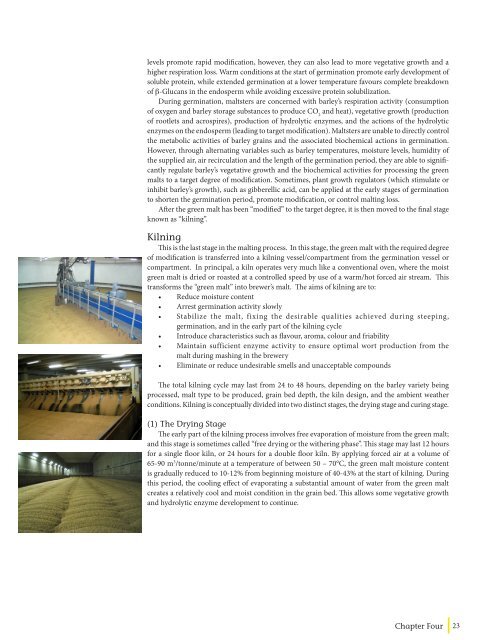MALTING QUALITY TRAITS - Canadian Malting Barley Technical ...
MALTING QUALITY TRAITS - Canadian Malting Barley Technical ...
MALTING QUALITY TRAITS - Canadian Malting Barley Technical ...
You also want an ePaper? Increase the reach of your titles
YUMPU automatically turns print PDFs into web optimized ePapers that Google loves.
levels promote rapid modification, however, they can also lead to more vegetative growth and a<br />
higher respiration loss. Warm conditions at the start of germination promote early development of<br />
soluble protein, while extended germination at a lower temperature favours complete breakdown<br />
of b-Glucans in the endosperm while avoiding excessive protein solubilization.<br />
During germination, maltsters are concerned with barley’s respiration activity (consumption<br />
of oxygen and barley storage substances to produce CO 2 and heat), vegetative growth (production<br />
of rootlets and acrospires), production of hydrolytic enzymes, and the actions of the hydrolytic<br />
enzymes on the endosperm (leading to target modification). Maltsters are unable to directly control<br />
the metabolic activities of barley grains and the associated biochemical actions in germination.<br />
However, through alternating variables such as barley temperatures, moisture levels, humidity of<br />
the supplied air, air recirculation and the length of the germination period, they are able to significantly<br />
regulate barley’s vegetative growth and the biochemical activities for processing the green<br />
malts to a target degree of modification. Sometimes, plant growth regulators (which stimulate or<br />
inhibit barley’s growth), such as gibberellic acid, can be applied at the early stages of germination<br />
to shorten the germination period, promote modification, or control malting loss.<br />
After the green malt has been “modified” to the target degree, it is then moved to the final stage<br />
known as “kilning”.<br />
Kilning<br />
This is the last stage in the malting process. In this stage, the green malt with the required degree<br />
of modification is transferred into a kilning vessel/compartment from the germination vessel or<br />
compartment. In principal, a kiln operates very much like a conventional oven, where the moist<br />
green malt is dried or roasted at a controlled speed by use of a warm/hot forced air stream. This<br />
transforms the “green malt” into brewer’s malt. The aims of kilning are to:<br />
• Reduce moisture content<br />
• Arrest germination activity slowly<br />
• Stabilize the malt, fixing the desirable qualities achieved during steeping,<br />
germination, and in the early part of the kilning cycle<br />
• Introduce characteristics such as flavour, aroma, colour and friability<br />
• Maintain sufficient enzyme activity to ensure optimal wort production from the<br />
malt during mashing in the brewery<br />
• Eliminate or reduce undesirable smells and unacceptable compounds<br />
The total kilning cycle may last from 24 to 48 hours, depending on the barley variety being<br />
processed, malt type to be produced, grain bed depth, the kiln design, and the ambient weather<br />
conditions. Kilning is conceptually divided into two distinct stages, the drying stage and curing stage.<br />
(1) The Drying Stage<br />
The early part of the kilning process involves free evaporation of moisture from the green malt;<br />
and this stage is sometimes called “free drying or the withering phase”. This stage may last 12 hours<br />
for a single floor kiln, or 24 hours for a double floor kiln. By applying forced air at a volume of<br />
65-90 m 3 /tonne/minute at a temperature of between 50 – 70°C, the green malt moisture content<br />
is gradually reduced to 10-12% from beginning moisture of 40-43% at the start of kilning. During<br />
this period, the cooling effect of evaporating a substantial amount of water from the green malt<br />
creates a relatively cool and moist condition in the grain bed. This allows some vegetative growth<br />
and hydrolytic enzyme development to continue.<br />
Chapter Four<br />
23


